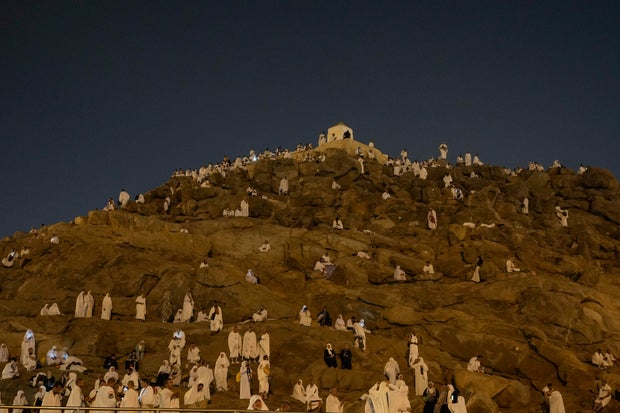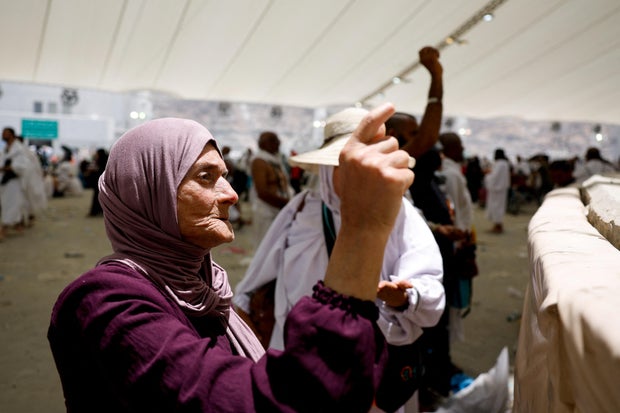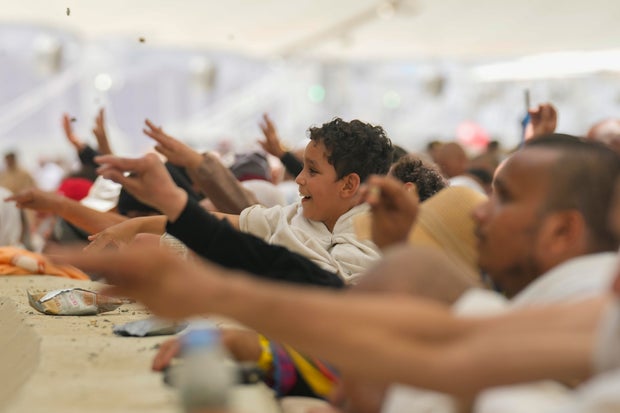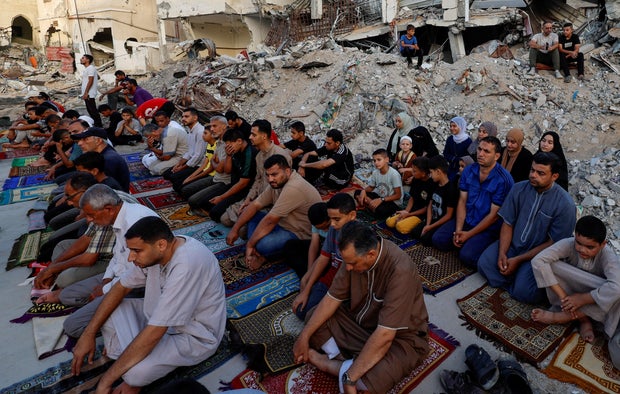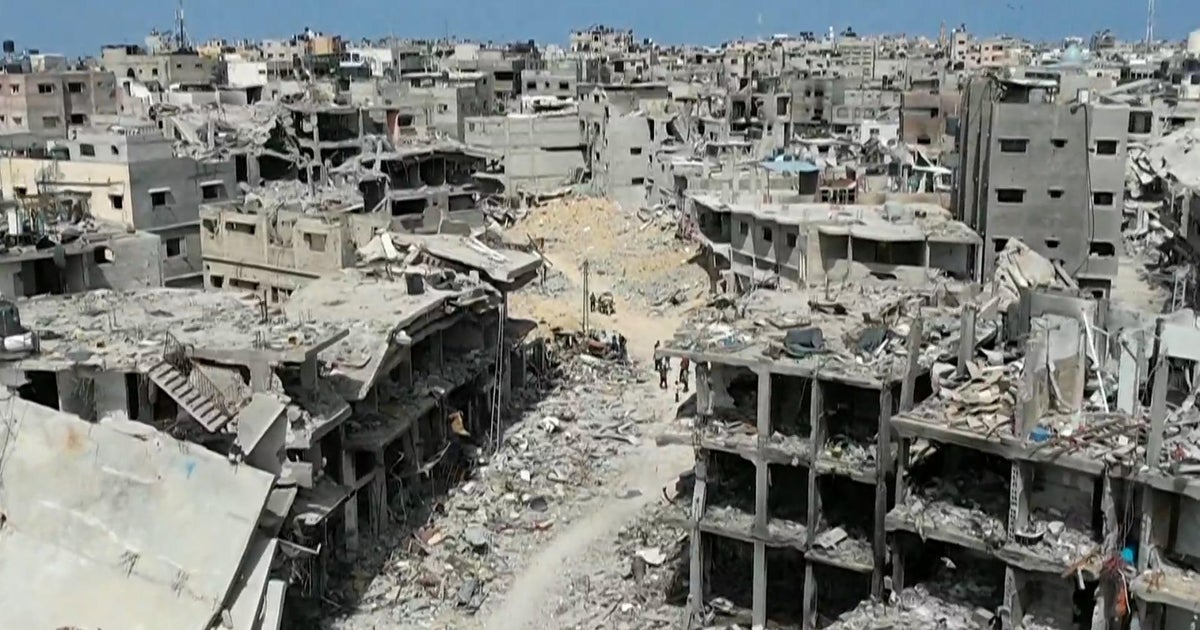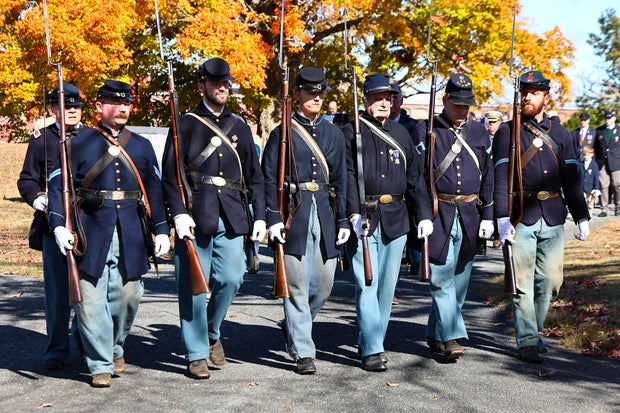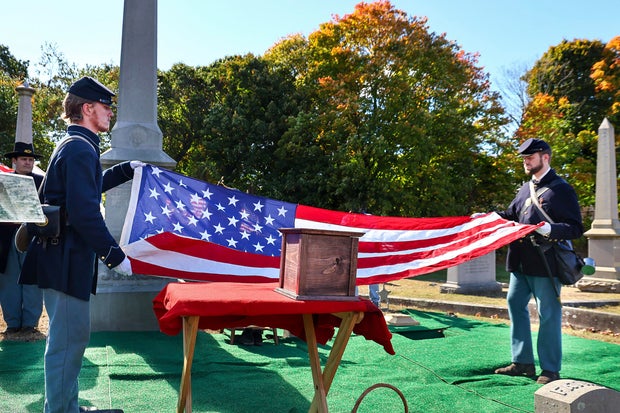CBS News
Pilgrims begin the final rites of Hajj as Muslims celebrate Eid al-Adha

Masses of pilgrims on Sunday embarked on a symbolic stoning of the devil in Saudi Arabia under the soaring summer heat. The ritual marks the final days of the Hajj, or Islamic pilgrimage, and the start of the Eid al-Adha celebrations for Muslims around the world.
The stoning is among the final rites of the Hajj, which is one of the Five Pillars of Islam. It came a day after more than 1.8 million pilgrims congregated at a sacred hill, known as Mount Ararat, outside the holy city of Mecca, which Muslim pilgrims visit to perform the annual five-day rituals of Hajj.
The pilgrims left Mount Arafat on Saturday evening to spend their night in a nearby site known as Muzdalifa, where they collected pebbles to use in the symbolic stoning of pillars representing the devil.
Rafiq Maqbool / AP
The pillars are in another sacred place in Mecca, called Mina, where Muslims believe Ibrahim’s faith was tested when God commanded him to sacrifice his only son Ismail. Ibrahim was prepared to submit to the command, but then God stayed his hand, sparing his son. In the Christian and Jewish versions of the story, Abraham is ordered to kill his other son, Isaac.
On Sunday morning, crowds headed on foot to the stoning areas. Some were seen pushing disabled pilgrims on wheelchairs on a multi-lane road leading to the complex housing the large pillars. Most pilgrims were seen sweltering and carrying umbrellas to protect them against the burning summer sun.
An Associated Press reporter saw many pilgrims, especially among the elderly, collapsing on the road to the pillars because of the burning heat. Security forces and medics were deployed to help, carrying those who fainted on gurneys out of the heat to ambulances or field hospitals. As the temperature spiked by midday, more people required medical help. The heat had reached to 47 C (116.6 F) in Mecca, and 46 C (114.8 F) in Mina, according to Saudi meteorological authorities.
Despite the suffocating heat, many pilgrims expressed joy at being able to complete their pilgrimage.
“Thank God, (the process) was joyful and good,” said Abdel-Moaty Abu Ghoneima, an Egyptian pilgrim. “No one wants more than this.”
Mohamad Torokman / REUTERS
Many pilgrims will spend up to three days in Mina, each casting seven pebbles at three pillars in a ritual to symbolize the casting away of evil and sin.
While in Mina, they will visit Mecca to perform their “tawaf,” or circumambulation, which is circling the Kaaba in the Grand Mosque counterclockwise seven times. Then another circumambulation, the Farewell Tawaf, will mark the end of Hajj as pilgrims prepare to leave the holy city.
The rites coincide with the four-day Eid al-Adha, which means “Feast of Sacrifice,” when Muslims with financial means commentate Ibrahim’s test of faith through slaughtering livestock and animals and distributing the meat to the poor.
Most countries marked Eid al-Adha on Sunday. Others, like Indonesia, will celebrate it Monday.
Once the Hajj is over, men are expected to shave their heads and remove the shroud-like white garments worn during the pilgrimage, and women to snip a lock of hair in a sign of renewal and rebirth.
Most of the pilgrims then leave Mecca for the city of Medina, about 340 kilometers (210 miles) away, to pray in Prophet Muhammad’s tomb, the Sacred Chamber. The tomb is part of the prophet’s mosque, one of the three holiest sites in Islam, along with the Grand Mosque in Mecca and the Al Aqsa Mosque in Jerusalem.
Rafiq Maqbool / AP
All Muslims are required to make the Hajj once in their lives if they are physically and financially able to do so. Many wealthy Muslims make the pilgrimage more than once. The rituals largely commemorate the accounts of Prophet Ibrahim and his son Prophet Ismail, Ismail’s mother Hajar and Prophet Muhammad, according to the Quran, Islam’s holy book.
More than 1.83 million Muslims performed Hajj in 2024, Saudi Hajj and Umrah Minister Tawfiq bin Fawzan al-Rabiah said in a briefing, slightly less than last year’s figures when 1.84 million made the rituals.
Most of the Hajj rituals are held outdoors with little if any shade. It is set for the second week of Dhu al-Hijjah, the last month in the Islamic lunar calendar, so its time of the year varies. And this year the pilgrimage fell in the burning summer of Saudi Arabia.
This year’s Hajj came against the backdrop of the devastating Israel-Hamas war, which has pushed the Middle East to the brink of a regional conflict.
Palestinians in the Gaza Strip weren’t able to travel to Mecca for Hajj this year because of the closure of the Rafah crossing in May when Israel extended its ground offensive to the city on the border with Egypt. And they will not be able to celebrate the Eid al-Adha as they used to do in previous years.
Dozens of Palestinians gathered Sunday morning near a destroyed mosque in Gaza’s southern city of Khan Younis to perform the Eid prayers. They were surrounded by debris and rubble of collapsed houses. In the nearby town of Deir al-Balah in central Gaza, Muslims held their prayers in a school-turned shelter. Some, including women and children, went to cemeteries to visit the graves of loved ones.
Mohammed Salem / REUTERS
“Today, after the ninth month, more than 37,000 martyrs, more than 87,000 wounded, and hundreds of thousands of homes were destroyed,” Abdulhalim Abu Samra, a displaced Palestinian, told the AP after wrapping up the prayers in Khan Younis. “Our people live in difficult circumstances.”
Also in the occupied West Bank, Palestinians convened for the Eid prayers in Ramallah, the seat of the Western-backed Palestinian Authority. “We suffer greatly and live through difficult moments with (what’s happening to) our brothers in Gaza,” said Mahmoud Mohana, a mosque imam.
In Yemen’s Houthi-held capital of Sanaa and in Iraq’s capital, Baghdad, Muslims celebrated and prayed for the war-weary Palestinians in Gaza.
“We are happy because of Eid but our hearts are filled with anguish when we see our brothers in Palestine,” said Bashar al-Mashhadani, imam of al-Gilani Mosque in Baghdad. “(We) urge the Arabic and Islamic countries to support and stand beside them in this ordeal.”
In Lebanon where the militant Hezbollah group traded nearly daily attacks with Israel, a steady stream of visitors made their way into the Palestine Martyrs Cemetery near the Shatila Palestinian refugee camp in Beirut early Sunday morning, bearing flowers and jugs of water for the graves of their loved ones, an annual tradition on the first day of Eid.
The cemetery is the burial site of many Palestinian Liberation Organization leaders and militants who died fighting Israeli forces in Lebanon in the 1970s and ’80s. More recently, top Hamas official Saleh al-Arouri and two other Hamas members, killed with him in an apparent Israeli airstrike in Beirut’s southern suburbs in January, were buried there.
CBS News
2 shot dead, 4 wounded by Mexico’s National Guard on migrant smuggling route near U.S. border

Mexico’s National Guard fatally shot two Colombians and wounded four others in what the Defense Department claimed was a confrontation near the U.S. border.
Colombia’s foreign ministry said in a statement Sunday that all of the victims were migrants who had been “caught in the crossfire.” It identified the dead as a 20-year-old man and a 37-year-old woman, and gave the number of Colombians wounded as five, not four. There was no immediate explanation for the discrepancy. The victims were identified by the foreign ministry as Yuli Vanessa Herrera Marulanda and Ronaldo Andrés Quintero Peñuelas.
Mexico’s Defense Department, which controls the National Guard, did not respond to requests for comment Monday on whether the victims were migrants, but it said one Colombian who was not injured in the shootings was turned over to immigration officials, suggesting they were.
If they were migrants, it would mark the second time in just over a month that military forces in Mexico have opened fire on and killed migrants.
On Oct. 1, the day President Claudia Sheinbaum took office, soldiers opened fire on a truck, killing six migrants in the southern state of Chiapas. An 11-year-old girl from Egypt, her 18-year-old sister and a 17-year-old boy from El Salvador died in that shooting, along with people from Peru and Honduras.
The most recent shootings happened Saturday on a dirt road near Tecate, east of Otay Mesa on the California border, that is frequently used by Mexican migrant smugglers, the department said in a statement late Sunday.
The Defense Department said a militarized National Guard patrol came under fire after spotting two vehicles — a gray pickup and a white SUV — in the area, which is near an informal border crossing and wind power generation plant known as La Rumorosa.
One truck sped off and escaped. The National Guard opened fire on the other truck, killing two Colombians and wounding four others. There was no immediate information on their conditions, and there were no reported casualties among the guardsmen involved.
One Colombian and one Mexican man were found and detained unharmed at the scene, and the departments said officers found a pistol and several magazines commonly used for assault rifles at the scene.
Colombians have sometimes been recruited as gunmen for Mexican drug cartels, which are also heavily involved in migrant smuggling. But the fact the survivor was turned over to immigration officials and that the Foreign Relations Department contacted the Colombian consulate suggests they were migrants.
Cartel gunmen sometimes escort or kidnap migrants as they travel to the U.S. border. One possible scenario was that armed migrant smugglers may have been in one or both of the trucks, but that the migrants were basically unarmed bystanders.
The defense department said the three National Guard officers who opened fire have been taken off duty while the incident is being investigated.
Former president Andrés Manuel López Obrador, who left office Sept. 30, gave the military an unprecedentedly wide role in public life and law enforcement; he created the militarized Guard and used the combined military forces as the country’s main law enforcement agencies, supplanting police. The Guard has since been placed under the control of the army.
But critics say the military is not trained to do civilian law enforcement work. Moreover, lopsided death tolls in such confrontations – in which all the deaths and injuries occur on one side – raise suspicions among activists whether there really was a confrontation.
For example, the soldiers who opened fire in Chiapas – who have been detained pending charges – claimed they heard “detonations” prior to opening fire. There was no indication any weapons were found at the scene.
CBS News
Kenyan man convicted of plotting 9/11-style attack on U.S.

A Kenyan man was convicted Monday of plotting a 9/11-style attack on a U.S. building on behalf of the terrorist organization al-Shabab.
A federal jury in Manhattan found Cholo Abdi Abdullah guilty on all six counts he faced for conspiring to hijack an aircraft and slam it into a building, according to court records.
He’s due to be sentenced next March and faces a mandatory minimum of 20 years in prison.
Handout / Criminal Investigation and Detection Group
Abdullah represented himself during the trial, which opened last week. He declined to give an opening statement and did not actively participate in questioning witnesses.
In court papers filed ahead of the trial, prosecutors said Abdullah intended to “merely sit passively during the trial, not oppose the prosecution and whatever the outcome, he would accept the outcome because he does not believe that this is a legitimate system.”
Lawyers appointed to assist Abdullah in his self-defense didn’t respond to an email seeking comment Monday.
Federal prosecutors, who rested their case Thursday, said Abdullah plotted the attack for four years, undergoing extensive training in explosives and how to operate in secret and avoid detection.
He then moved to the Philippines in 2017 and began training as a commercial pilot.
Abdullah was almost finished with his two-year pilot training when he was arrested in 2019 on local charges.
He was transferred the following year to U.S. law enforcement authorities, who charged him with terrorism-related crimes.
Prosecutors said Abdullah also researched how to breach a cockpit door and information “about the tallest building in a major U.S. city” before he was caught.
The State Department in 2008 designated al-Shabab, which means “the youth” in Arabic, as a foreign terrorist organization. The militant group is an al Qaeda affiliate that has fought to establish an Islamic state in Somalia based on Shariah law.
CBS News
The remains of 28 Civil War soldiers were found in a funeral home’s storage. They’ve now been laid to rest.

For several decades, the cremated remains of more than two dozen American Civil War veterans languished in storage facilities at a funeral home and cemetery in Seattle.
The simple copper and cardboard urns gathering dust on shelves only had the name of each of the 28 soldiers – but nothing linking them to the Civil War. Still, that was enough for an organization dedicated to locating, identifying and interring the remains of unclaimed veterans to conclude over several years that they were all Union soldiers deserving of a burial service with military honors.
“It’s amazing that they were still there and we found them,” said Tom Keating, the Washington state coordinator for the Missing In America Project, which turned to a team of volunteers to confirm their war service through genealogical research. “It’s something long overdue. These people have been waiting a long time for a burial.”
Most of the veterans were buried in August at Washington’s Tahoma National Cemetery.
In a traditional service offered to Civil War veterans, the historical 4th U.S. Infantry Regiment dressed in Union uniforms fired musket volleys and the crowd sang “The Battle Hymn of the Republic.” Names were called out for each veteran and their unit before their remains were brought forward and stories were shared about their exploits. Then, they were buried.
Among them was a veteran held at a Confederate prison known as Andersonville. Several were wounded in combat and others fought in critical battles including Gettysburg, Stones River and the Atlanta campaign. One man survived being shot thanks to his pocket watch – which he kept until his death – and another deserted the Confederate Army and joined the Union forces.
“It was something, just the finality of it all,” Keating said, adding they were unable to find any living descendants of the veterans.
While some remains are hidden away in funeral homes, others were found where they fell in battle or by Civil War re-enactors combing old graveyards.
Charles Lawrence / AP
Communities often turn reburials into major events, allowing residents to celebrate veterans and remember a long-forgotten war. In 2016, a volunteer motorcycle group escorted the remains of one veteran cross country from Oregon to the final resting place in Maine. In South Carolina, the remains of 21 Confederate soldiers recovered from forgotten graves beneath the stands of a military college’s football stadium were reburied in 2005.
Sometimes reburials spark controversy. The discovery of the remains of two soldiers from the Manassas National Battlefield in Virginia prompted an unsuccessful attempt in 2018 by several families to have DNA tests done on them. The Army rejected that request and reburied them as unknown soldiers at Arlington National Cemetery.
Along with those buried at Tahoma, Keating said, several others will be buried at Washington State Veterans Cemetery and a Navy veteran will be buried at sea. The remains of several more Civil War veterans were sent to Maine, Rhode Island and other places where family connections were found.
“Would have been lost to history”
Among them was Byron Johnson. Born in Pawtucket in 1844, he enlisted at 18 and served as a hospital steward with the Union Army. He moved out West after the war and died in Seattle in 1913. After his remains were delivered to Pawtucket City Hall, he was buried with military honors at his family’s plot in Oak Grove Cemetery.
Pawtucket Mayor Donald R. Grebien said Johnson’s burial service was the right thing to do.
“When you have somebody who served in a war but especially this war, we want to honor them,” he said. “It became more intriguing when you think this individual was left out there and not buried in his own community.”
Grebien said the burials recall important lessons about the 1861-1865 war to preserve the Union, fought between the North’s Union Army and the Confederate States of America at a cost of hundreds of thousands of lives.
“It was important to remind people not only in Pawtucket but the state of Rhode Island and nationwide that we have people who sacrificed their lives for us and for a lot of the freedoms we have,” he said.
Bruce Frail and his son Ben – both long active in the Sons of Union Veterans of the Civil War – were on hand for service. Ben Frail was also a re-enactor at Johnson’s service, portraying a Union Army captain.
Charles Lawrence / AP
“It’s the best thing we can do for a veteran,” said Bruce Frail, a former commander-in-chief with the Sons of Union Veterans and state coordinator for Missing In America Project.
“The feeling that you get when you honor somebody in that way, it’s indescribable,” he said.
The Missing in America Project says it has identified the remains of over 7,000 veterans and has buried over 6,800 soldiers.
The task of piecing together Johnson’s life story was left to Amelia Boivin, the constituent liaison in the Pawtucket mayor’s office. A history buff, she recalled getting the call requesting the city take possession of his remains and bury them with his family. She got to work and Johnson’s story became the talk of City Hall.
She determined Johnson grew up in Pawtucket, had two sisters and a brother and worked as a druggist after the war. He left to make his fortune out West, first in San Francisco and eventually in Seattle, where he worked nearly up until his death. It doesn’t appear Johnson ever married or had children, and no living relatives were found.
“I felt like it was resolution of sorts,” Boivin said. “It felt like we were doing right for someone who otherwise would have been lost to history.”
Earlier this year, two Union soldiers were posthumously honored by President Biden with the Medal of Honor for their courage in the “Great Locomotive Chase,” in which they went deep behind Confederate lines and stole a train in Marietta, Georgia. They ran the train north, tearing up tracks and cutting telegraph wires as they went.


